May 2021 surround you with love, happiness, good health…. AND drought-loving friends!
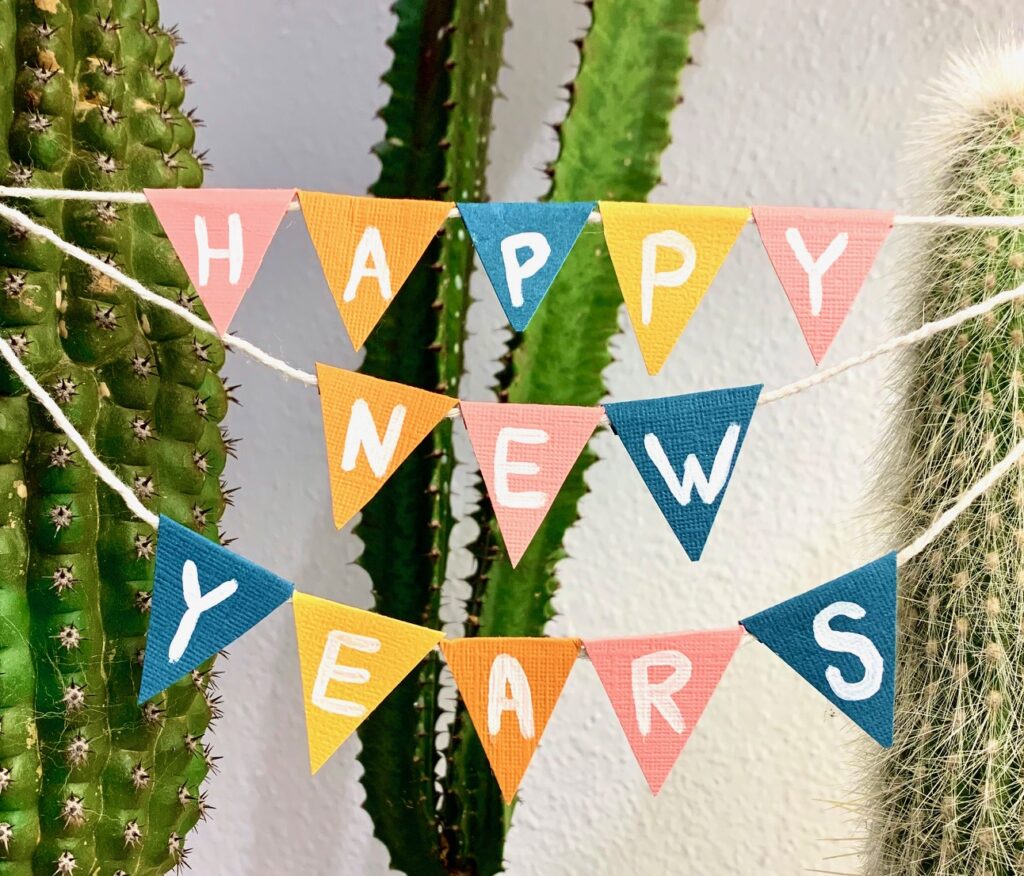
May 2021 surround you with love, happiness, good health…. AND drought-loving friends!

While staying in Oregon for a few months during the pandemic, I found out about Yaquina Nursery that specialize in cactus and succulents. The day before I returned to Seattle for good, I decided to take a mini road trip to see this Yachats gem.

It was a melting 95 degrees while driving along scenic Hwy 34, through the tiny, rural town of Alsea and the beautiful Siuslaw National Forest.
Although once located in Newport, owners Bob and Gerri Foss moved their nursery inland to the eastern farmlands of Yachats 12 years ago. So, once I arrived expecting some relief from the coastal breeze, that was unfortunately not the case. What I did find on this sweltering day were greenhouses filled with over 7,000 species of cacti & succulents, lined neatly by species as far as the eye could see!

I met Steve, one of the 3 employees but the only one on site that day, and Gerri. Although Gerri was busy potting up newly rooted succulents, she was kind enough to take a break and give me a quick tour and history of her nursery.
Her husband, Roy, started the business 52 years ago; starting with $600 worth of seeds! She said they’re the biggest cactus and succulent growers “West of Mississippi and North of San Francisco”. Gerri and Roy pack up their RV and make deliveries to their Oregon retailers, and as they live on-site, are open to the public every single day.
Asked what her favorite cactus is, with a twinkle in her eye, she said “anything flowering!”.
Naturally the greenhouses were absolutely cooking that day in particular, however Steve detected my excitement so patiently showed me through the greenhouses. Dozens of different types of mammillarias were in full bloom and the entire nursery was alive with color! We quickly decompressed outside the greenhouses to catch our breath, then Steve showed me Roy’s “special greenhouse” that houses his collection of some of his favorite plants that the public rarely sees. I got the sense that Roy is a huge fan of Euphorbia obesas as he had rows-upon-rows of them. They were just stunning!
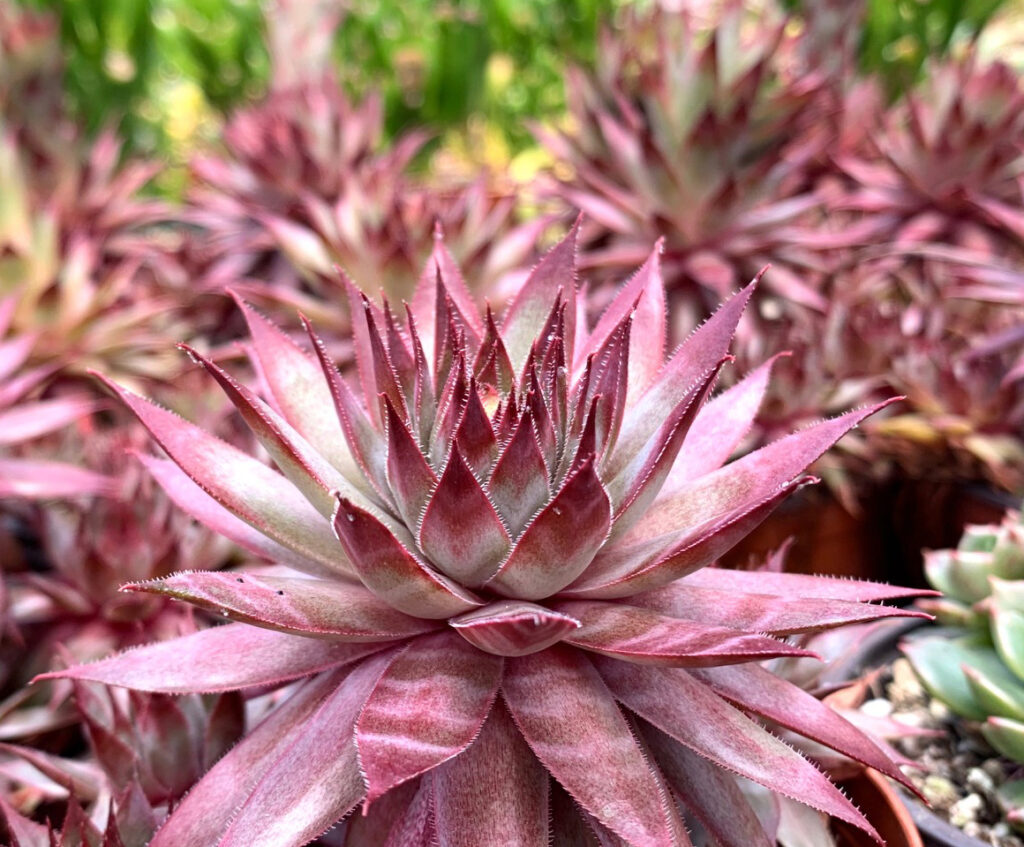
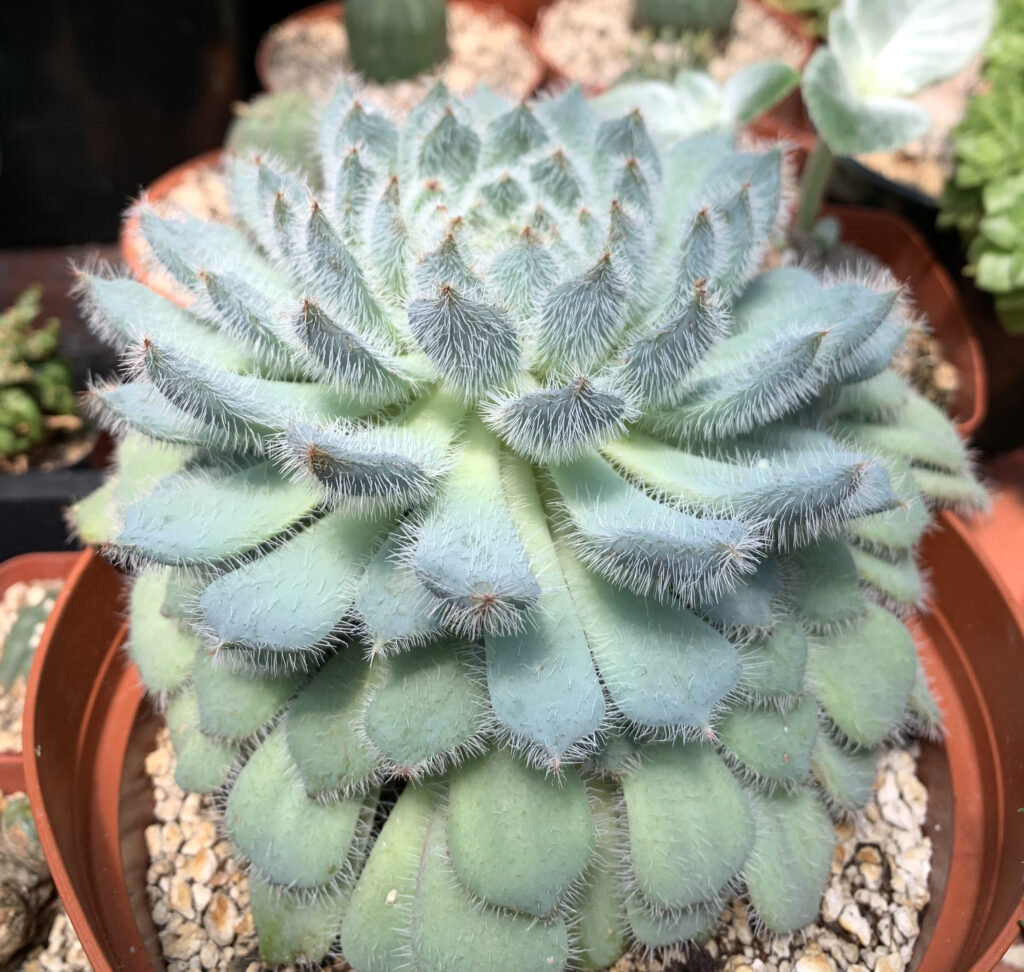

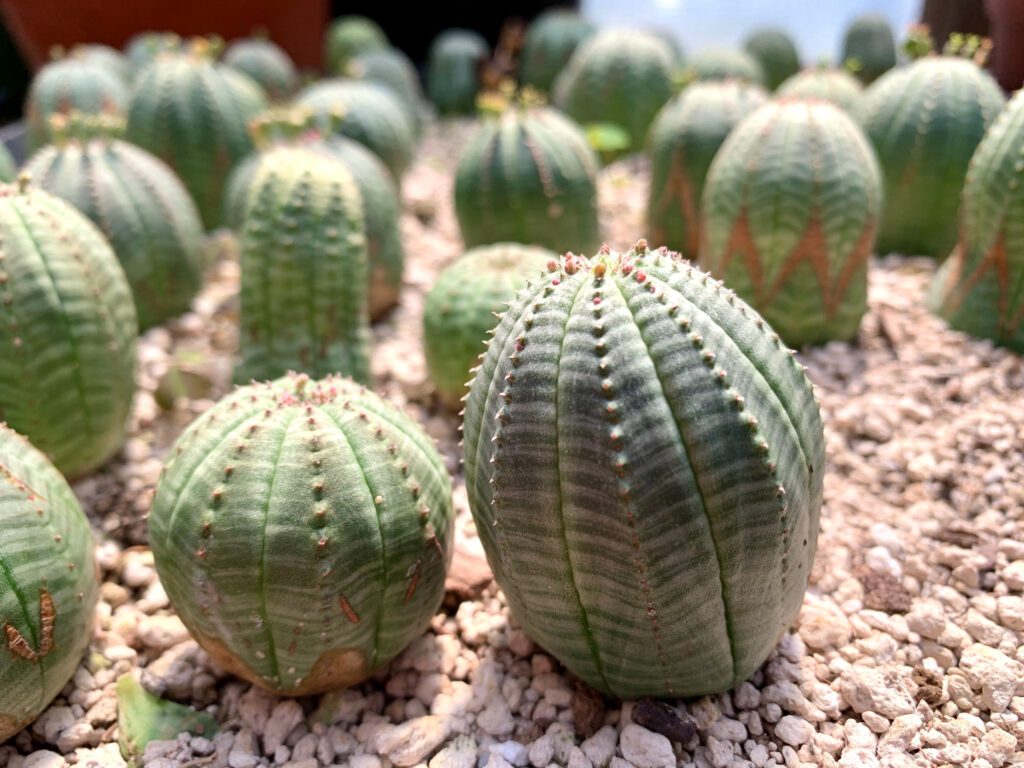
As the heat was getting unbearable both inside and outside the greenhouses, sadly I only lasted about an hour to ogle all the different species of plants. Steve noticed I was starting to wilt (pun intended) and laughed saying this heat was nothing compared to his years living in Florida.
Yes, I’m a wimp, but I’ll make sure next time I visit it’ll be a cloudy, spring day. I dashed out of there; allowing myself to spend $50 (yes, I already have regrets). I already can’t wait to go back. 🙂
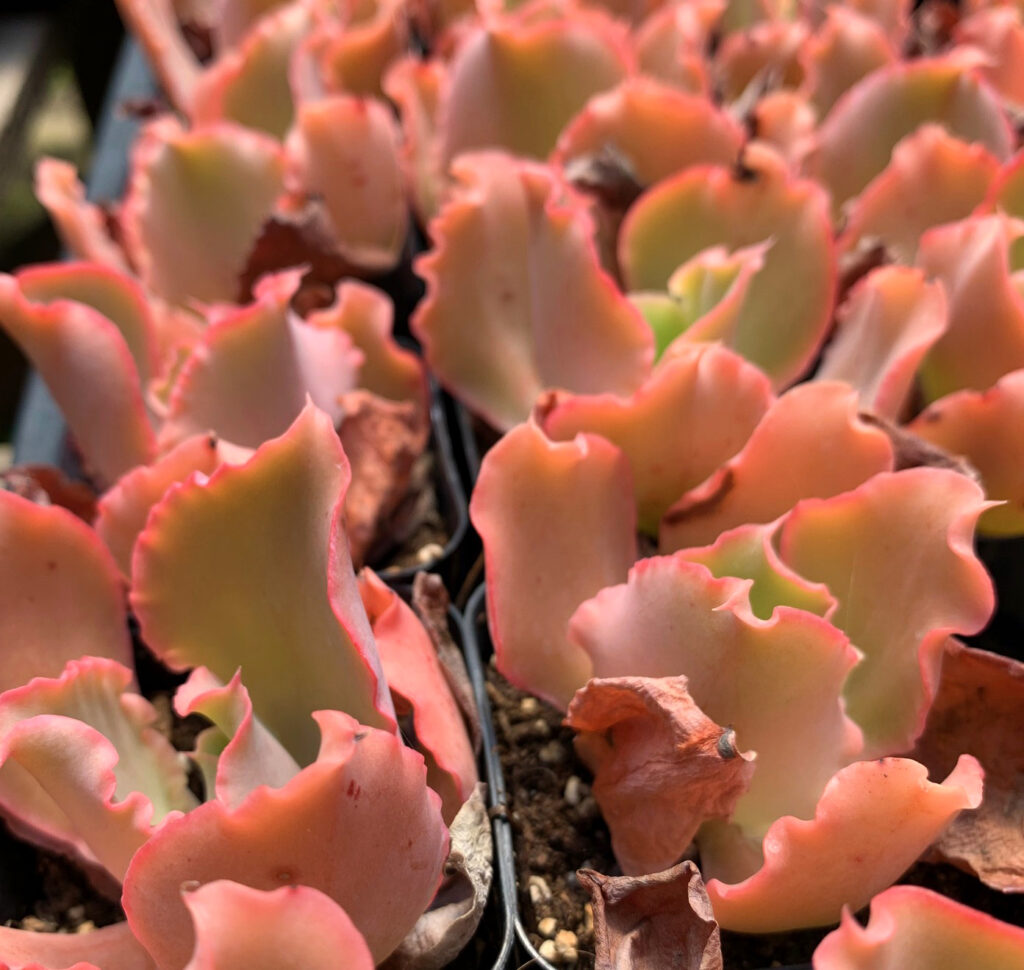


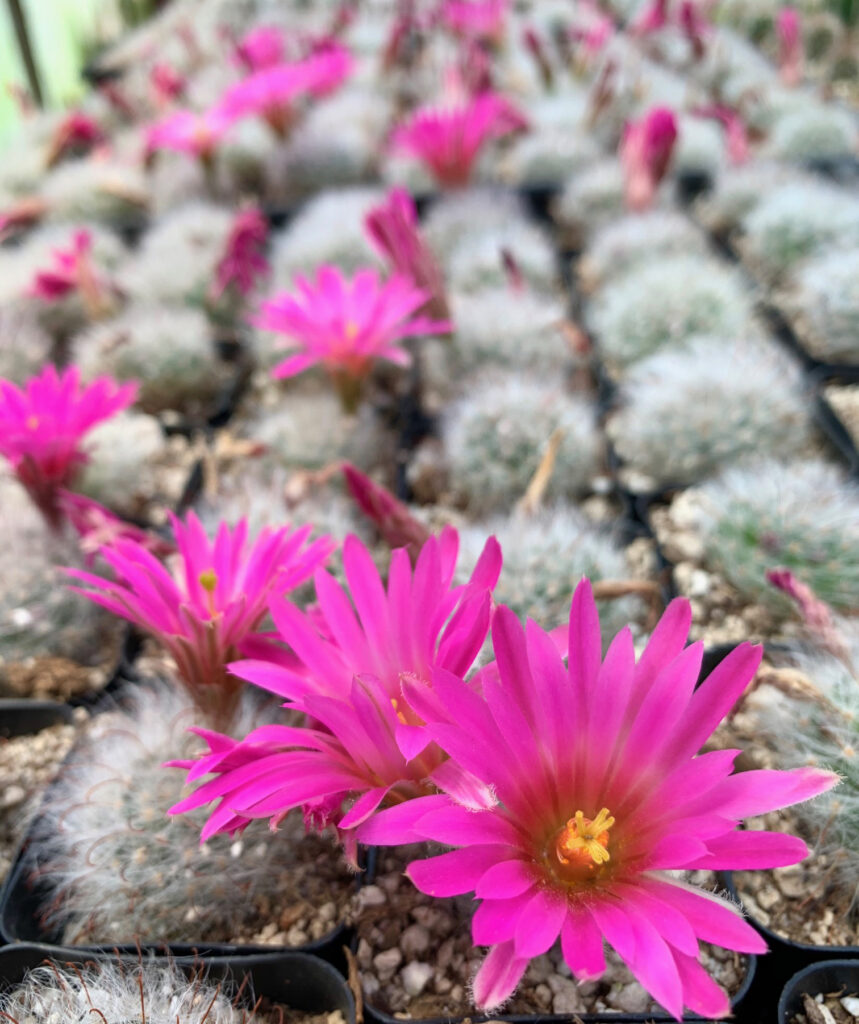


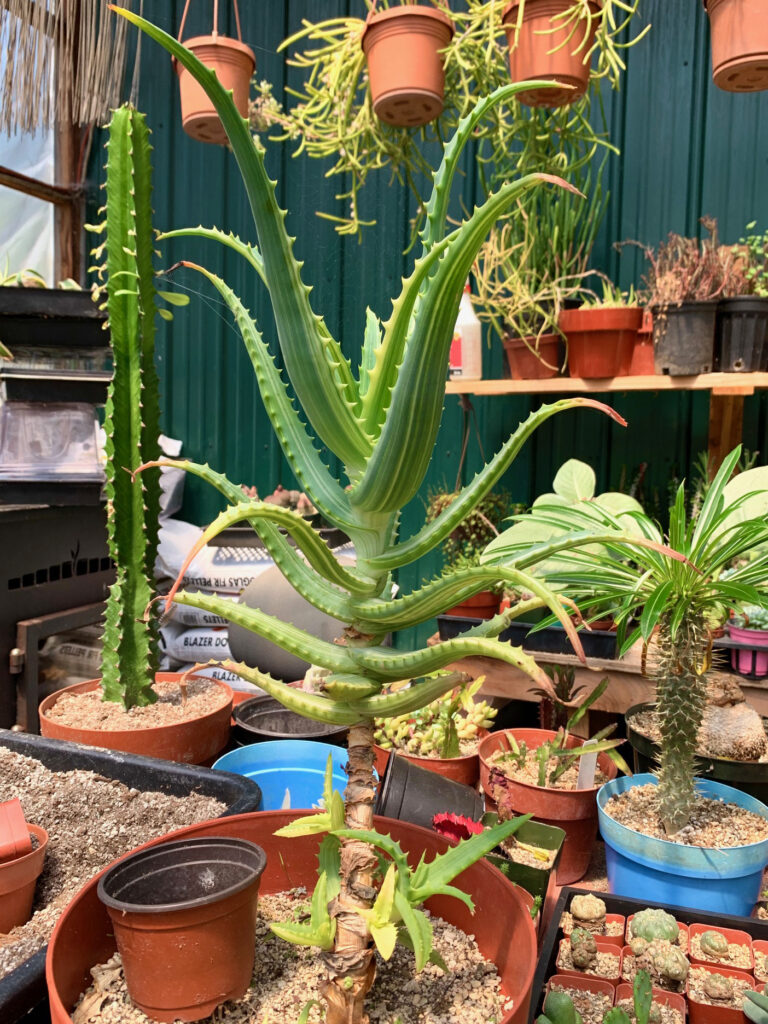

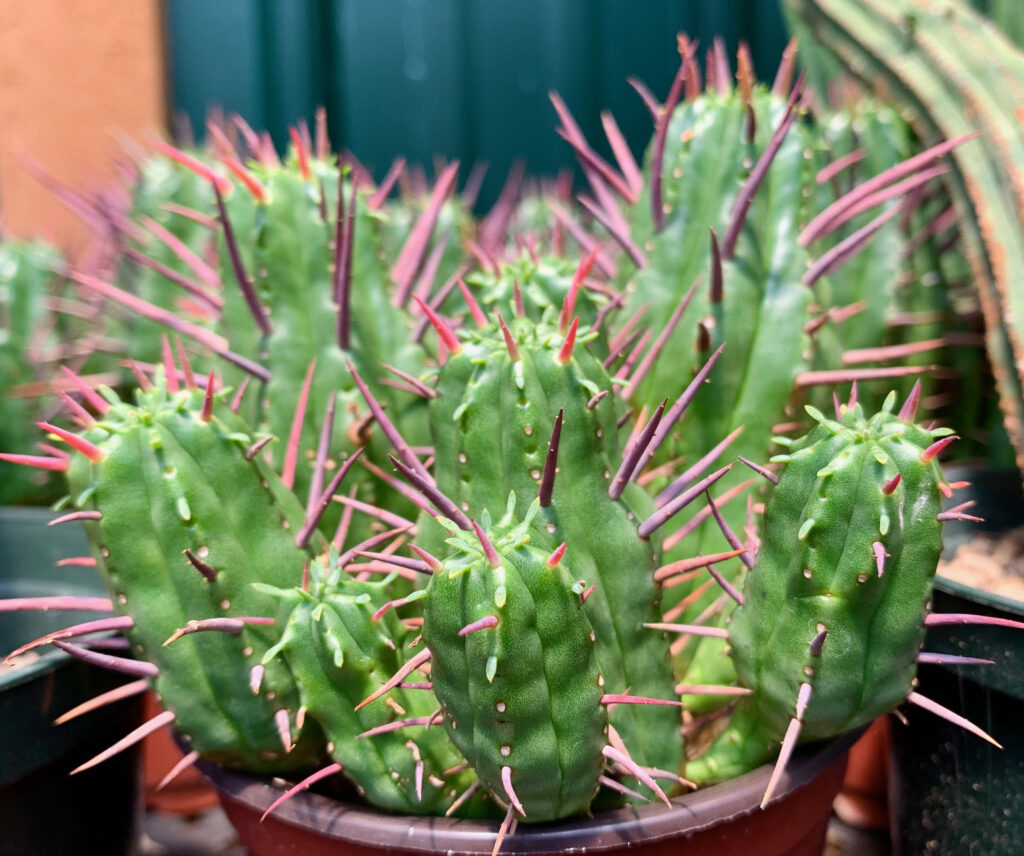
Our summer has arrived and with it increased growth and blooming of our cactus and succulents. We are enjoying the daily flower shows as well as the offsets we see peeking out from under “mom”. After several rains in early July, our plants are fat and robust.
After our fabulous field trip to Oregon, I thought that our local field trip to Bellevue, on the east side of Seattle might be a bit of a let down. However, we had a large turnout of folks eager to see what our local gardens have to offer. First we visited a demonstration garden at the Master Gardener’s locale in King County. Named for George Pinyuh, a local master gardener who had a passion for succulents, the garden was planted with a variety of plants tolerant of our droughty summers and sopping wet winters. Having seen this garden some years ago, I was astounded at the growth which has filled in most of the empty areas. With the sunshine, plants were in full color with a ruddy cast to them.

After a quick tailgate party of water and snacks, we headed off to Bellevue Botanical Garden to see the rock garden. Member George, who is also a member of the Rock Garden Society gave an excellent insider’s look at the gardens which have recently been refurbished. Apparently while we go to look at plants, children go to climb all over the rocks. Your imagination can fill in the result.

After a quick stop by the gift shop and coffee bar, we drove to member Denise’s home to see her outdoor plants as well as her indoor plants displayed on the picnic table. After walking through the yard and admiring succulents as well as trees and bushes, we arrived at the back yard where pleasant shaded sitting areas greeted us. We sank down to enjoy the ambiance and continue the conversations that started when we met at the first garden. The chatter would have gone on for some time had we not been interrupted by the early arrival of Denise’s first dinner guest for the evening. With quick thanks we scooted out and headed home to reflect in our cars about the wonderful afternoon of succulent camaraderie.

Denise has stepped up for two field trips in a row and knocked in a home run with both of them. Our club enjoys the efforts of many members who work behind the scenes to make our meetings worthwhile and enjoyable. While it’s a lot of work, there is the reward of much appreciation on the part of members.

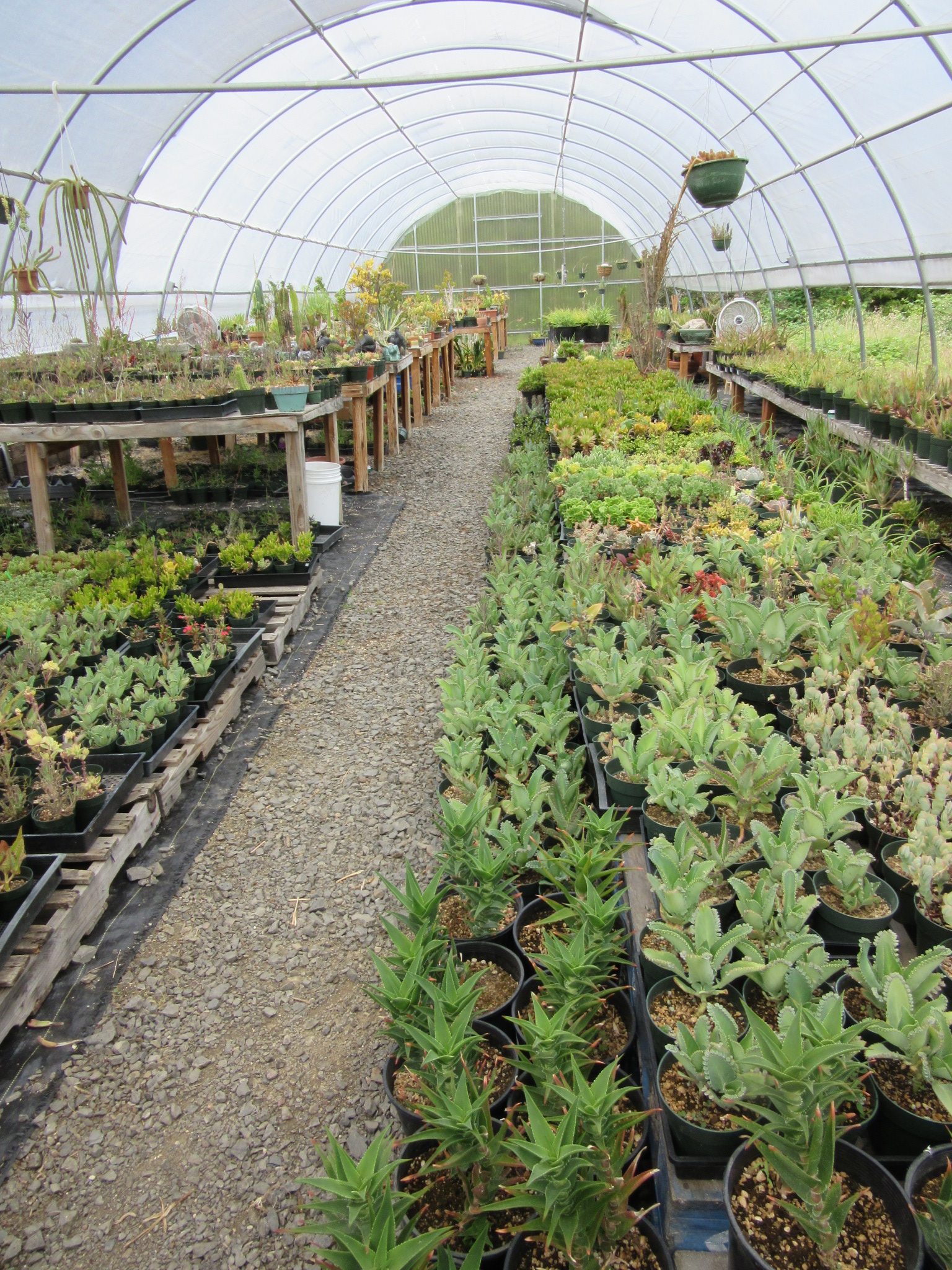
Our club spent the weekend of June 15 & 16 exploring the cactus and succulent highlights of northwest Oregon. We kicked off the trip with a visit to The Potted Elephant greenhouses, run by the highly engaging Cory and John. These guys love plants and there was a definite vibe. They set a high bar for the other stops along the way, none of which disappointed. We left their place with the beginnings of our trip plant collection.
From there we moved on to the Rare Plant Research Center where Burl Mostul and his wife have created a beautiful Mediterranean home. Since our last visit they have planted grape vines and now run a family winery named after their home, Villa Catalana. We toured the greenhouses where plants were lined up and labeled for sale, thereby increasing the number of plants in the trunk.
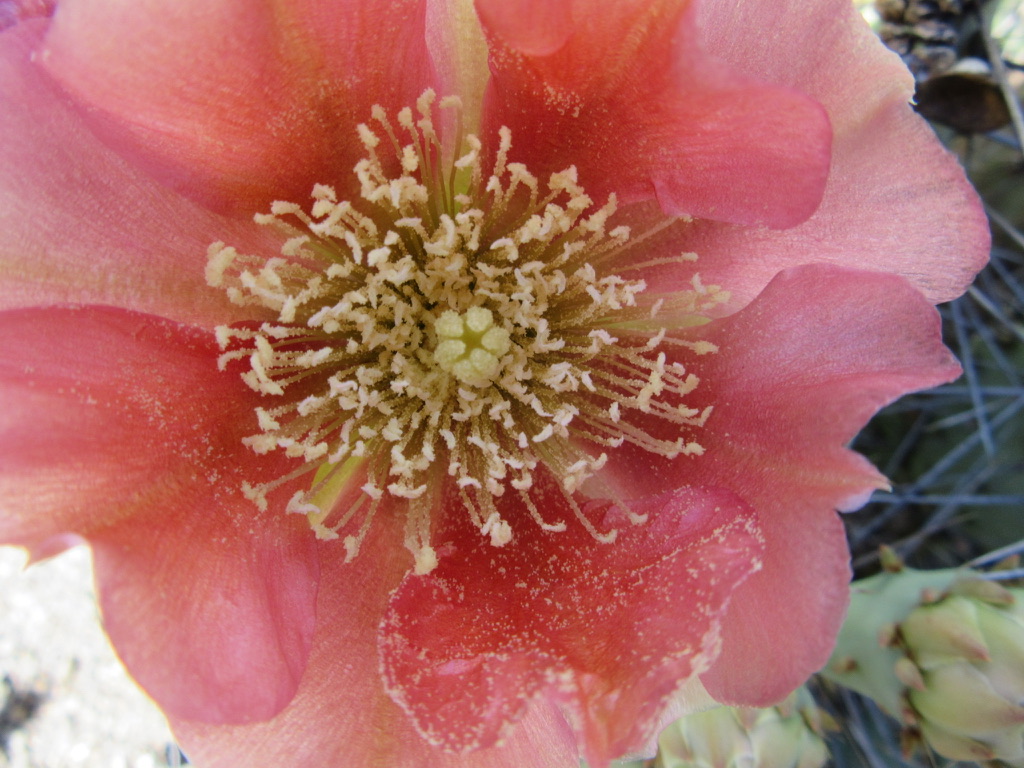 We then left the general Portland area and headed south to Salem for a Master Gardener tour of the Marion County demonstration garden. After seeing the xerigraphic garden, we wandered throughout the rest of the gardens to see a variety of experimental projects. The gardeners have been experimenting with strategies for growing vegetables in low water situations and had some interesting strategies to share.
We then left the general Portland area and headed south to Salem for a Master Gardener tour of the Marion County demonstration garden. After seeing the xerigraphic garden, we wandered throughout the rest of the gardens to see a variety of experimental projects. The gardeners have been experimenting with strategies for growing vegetables in low water situations and had some interesting strategies to share.
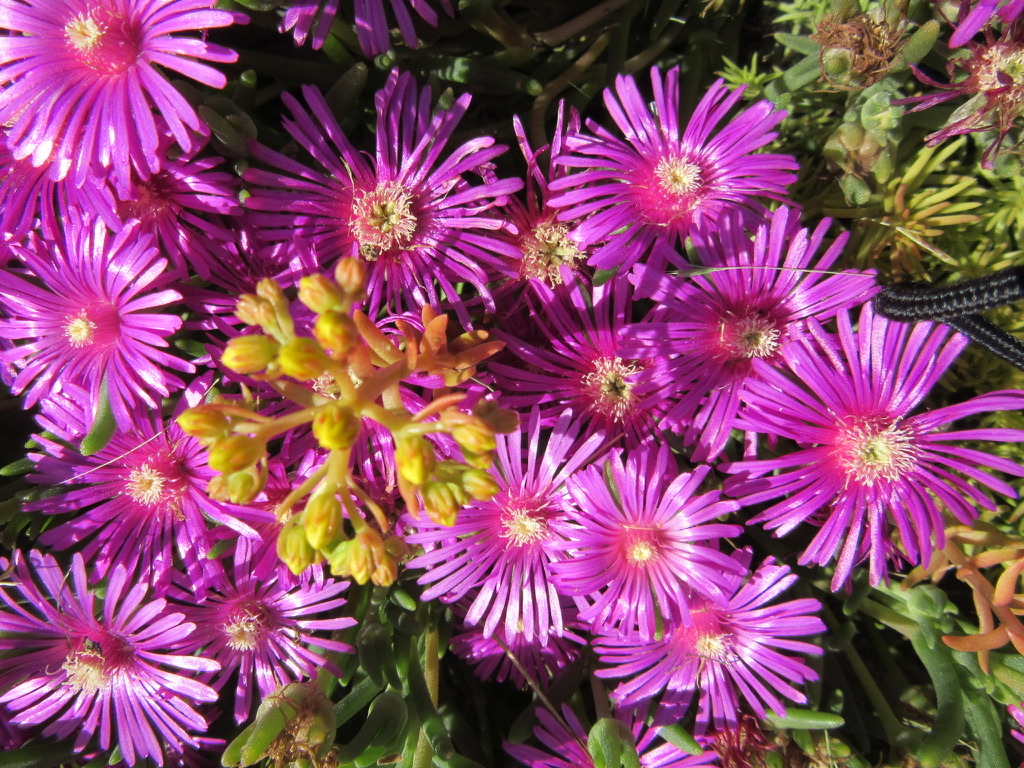
Being tired from the long day, we went to our motels for a short break before meeting for a seafood dinner. Joining us was Kevin Vaughn, known for his hybridization work with Sempervivums, iris and other plants. We chatted him up during dinner, learning that he started hybridizing at age 9, plays the oboe, and worked for the USDA for 30 years in Mississippi.
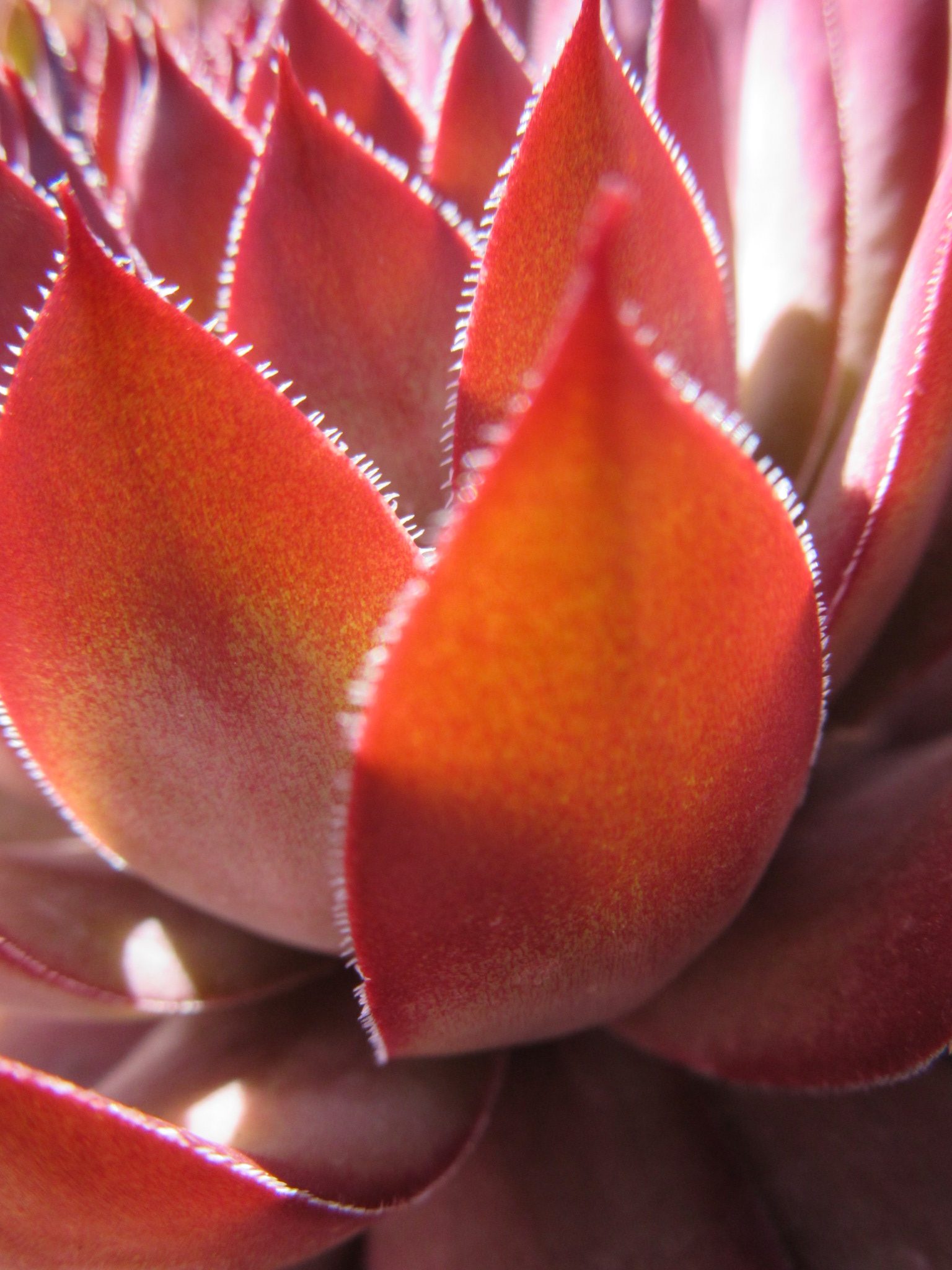
After a good night’s sleep, we headed to Kevin’s home on the south side of Salem and examined evidence of his hybridizing talents. With many gasps and exclamations we walked from one Sempervivum bed to another, witnessing the progression of his seedlings to adulthood and possibly into production for sale.
We reluctantly left the magical world of Kevin and his yard and went to Rita Lee’s nursery by way of Adelman Peony Gardens – closing for the season and offering sale prices. Can’t pass that up! Rita Lee’s Nursery started as the result of a packet of mixed cactus seeds brought back from Arizona as a souvenir. Now there are 5 amazingly organized greenhouses, with meticulously grown cactus and succulents. We left with more plants, plus a free one!
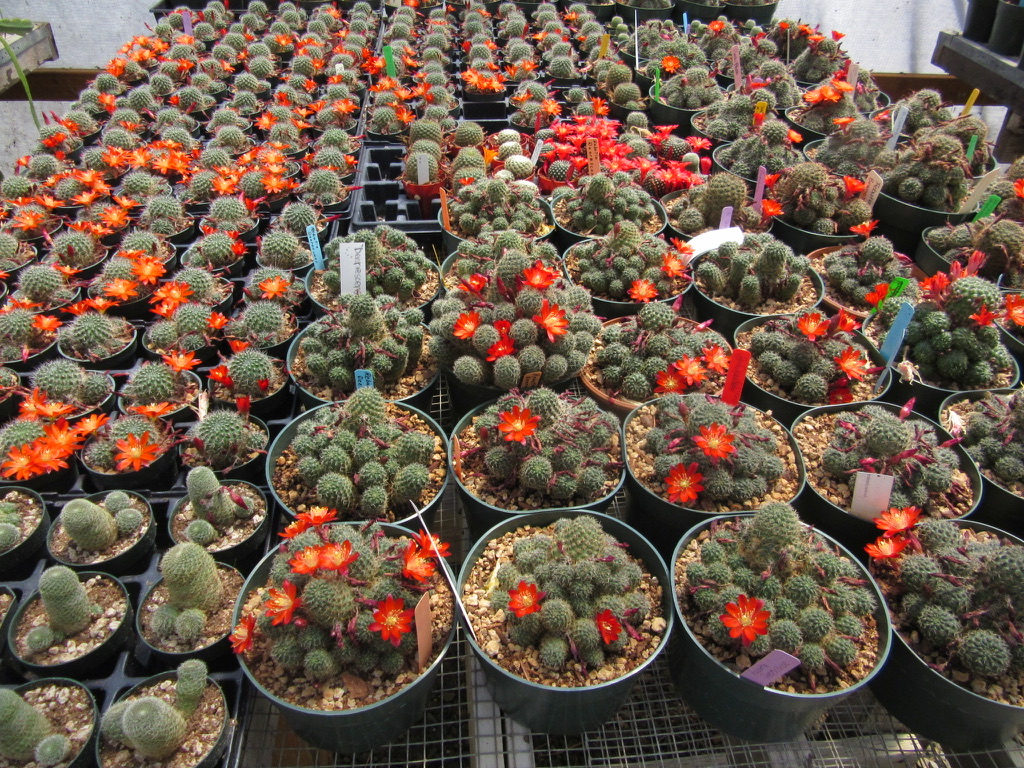
We spent a couple of pleasant hours in the company of the Oregon Cactus and Succulent Society. Laura Watson’s shady backyard in Portland was cool and refreshing on the warm day. We enjoyed a nice lunch, talked plant sales, programs, and speakers with fellow cactophiles then sped off to Suburban Succulents in Vancouver, WA.
This, our last stop, brought us to the home of Adriane Savelli, owner of Suburban Succulents. She propagates plants like crazy in her garage, the whole project overseen by two bunnies, who provide the fertilizer. She gave us the full tour including the window sills, patio, greenhouses, even the vegetable garden. We enjoyed tasty snacks while talking plants and entrepreneurship in the succulent world.
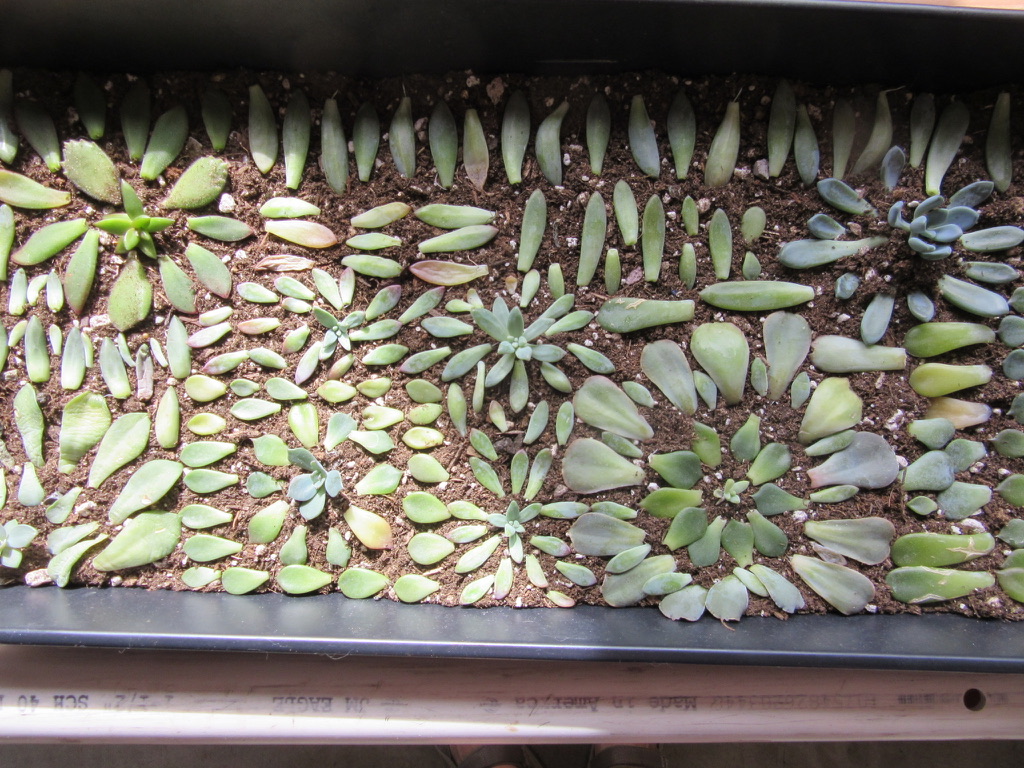
After our one to several feet of snow in February, we are now spending what is usually a rainy April and May basking in the sunshine of 60-80 degree days. Should we move the cacti and succulents out? Will we still get some of those 45 degree rainy days? It’s hard to tell at this point. Predictions are for another hot summer and a dry one. Our rain barrels are all full but the water won’t last long as we are already watering plants on the deck from our rainwater stash.
Many of our members are enjoying large dinner plate sized blooms on their epiphyllums. At our April meeting, one of our most ardent brag plant presenters brought in an array of orchids and bulbs in bloom. Another member brought in a breathtaking red epiphyllum with blooms at least 8 inches across. In both cases, the plants are grown in greenhouses. Our plants, grown in our home, tend to bloom later in June or July once they get outdoors.


Photo by Karen Summers
At the other end of the spectrum, seeds sown on March 20, 2019 have grown and are eagerly crowding out their neighbors. One of the things I’ve found that promotes the growth of seedlings is to crowd them.
I plant thickly on purpose and let them jostle each other for a year or two. I’ve found that the survival rate seems increased as a result of this. I’m not claiming a high survival rate, just an increased one.
On April 10, we were called into action to drive 3 hours to an area east of Wenatchee to retrieve many plants from the home of one of our members who was selling her property. It was a dry day, breezy and with a spring feel to it. We stood out in the middle of this beautiful piece of land- rocky and grassy with a wide open skies feel to it.
We pruned many varieties of Opuntia paddles, dug Lewisia from their rocky home, and tackled some of the Cholla and Yucca. It seemed that most of what was growing competed for the longest, nastiest spines. After bringing them home, many of the Opuntia paddles were taken to our April meeting where they were snapped up by members using salad tongs. Some were planted for our fall sale. Lewisia cotyledon were potted up and regardless of the upset of the move have been bursting into bloom.
Spring is a wonderful time of year – so much to do outdoors and with the plants. Each day brings new growth, new blooms, and a stronger connection to the natural cycle of plants.

Photo by Karen Summers
As a result of our last meeting, “The Great Frailea Repot” happened over two days in the greenhouse of one of our members. Some years ago, he willingly took in a tray of Frailea that had been donated to the club and no one else had room to adopt. Over the past several years the forgotten Frailea had happily reproduced in the back corner of his green house to the point that he had 13-15 cacti in a one inch pot. The Frailea looked a bit worse for it, too. While re-potting we managed to salvage many seeds, some of which are percolating in a flat in my laundry room as I write this. I have great hopes for many tiny, tiny Frailea babies.
With our warmer weather we are opening our greenhouse doors – out with the bad air and in with the good air. Repotting of our less crowded plants will begin soon. And then there is that first watering after the long winter dormancy.
Along with the commencement of growth has come the mealy bug army. I keep my alcohol spray bottle at the ready as I work with my plants. Unfortunately this year the mealies have gone after the Gasteria and Haworthia quickly decimating some of these plants. Perhaps since we’ve never had this problem with these plants before, we wasn’t as vigilant as we are with our Echinopsis which seems to breed it’s own mealy bugs.
While watching the tulips unfurl, we are already planning the big break out of plants from under plastic and into the yard. Each year we try to come up with the perfect design and each year we end up with plants all over the place, often in the walkways.
Our summer promises to be drier, hotter and in other ways following the trend of the past years. Our plants love this, but the native plants in our yard have begin to struggle a bit. It’s hard to imagine that our rainy Pacific Northwest is becoming a good place to grow cactus!
We celebrated spring a bit early at our March 17 meeting. The weather was balmy with a blue sky giving hope and promise after the deep snows of a month ago. Our plants are showing signs of spring growth which is always exciting. Many members are actively engaged in re-potting, propagating cuttings, and starting plants from seed.
There is nothing more exciting to me as a gardener than planting a seed and seeing an amazing plant grow from it. Two weeks ago I planted 16 different seed packets and the results have been beyond my dreams. Most exciting is the packet marked “unknown”. Right now the tiny green nubs look like all the other tiny green nubs.
At our March meeting the brag plants overflowed with a variety of bulbs and orchids in bloom. Even a rather harried looking Albuca was putting on a show.
The Frailea presentation for Cactus of the Month elicited many delighted remarks and an interest in acquiring this little dynamo. Fortunately one of our members has a stash in the back corner of his greenhouse in serious need of re-potting. These were donated to the club 5 or 6 years ago and when no one took them he took them and stuffed them in a corner. Being small they lend themselves to that. Now they have multiplied to the point of overflowing their pots. We are eagerly looking forward to potting up and selling these at our next meeting as well as our fall sale.
Our monthly program was on Gardens of England and having wanted to see the Chelsea Garden show for many years I savored the colorful slides presented. While England, like Washington state, isn’t know for its cactus and succulents, the climate lends itself to stunningly floral landscapes. The succulents become an accent point.
Spring is a time of change, reunion, and hope. We are all looking forward to what grows this year.
The month of February was one to remember for those of us growing succulents in the Pacific Northwest. We took a right to the jaw with 4 inches of snow fall, followed by a left to the jaw with another 5 inches, then a shot to the ribs with another 4 inches. Once it was all settled and iced over we had a foot of snow and freezing weather to keep it around. After living here for nearly 30 years, I can say I have never experienced anything like this. Yes, we get snow from time to time, but not usually a barrage of snowy freezing weather. Not this deep and not for so long.
Of first concern were the plants in the greenhouse. Were they warm enough? (no) Was the weight of the snow too much (yes). To add to our woes, the power went out leaving us scurrying out in hats, boots, and gloves in the dark, unloading the greenhouse and moving approximately 200 plants onto a tarp in the family room. In the rush, a few plants were dumped, some broken. We took advantage of the time indoors for some mid-winter plant care and addressed a couple of mealy bug issues.
At our February meeting members had an opportunity to share their personal horror stories as they dealt with plants kept under the eaves, in unheated greenhouses, and even in heated greenhouses. One of the scariest situations happened in the greenhouses of our member who grows many caudex plants and unusual plants in very full greenhouses. He had to hold the plants at just above freezing as he was nearly out of propane and the delivery truck couldn’t reach his home. As he described it, “It’s survival of the fittest.”
While it was an intense time for the humans, the plants we brought indoors showed signs of spring growth starting. Snow or not, spring is here as far as the plants are concerned. I am always amazed and impressed at the will to live hardwired into succulent plants. We know they are designed to survive in arid and harsh conditions, yet I see the same resiliency carrying them through some pretty cold weather. The critical factor being that they are completely dry.
As of this writing, we are seeing some sun, some warmer days and the early tulips and daffodils starting to show color. After going through some real winter, I think I appreciate the coming spring even more.
The fall season is full upon us, with leaves glowing and blowing through the yard. Not but a month ago, the spaces now claimed by fallen leaves were occupied by sunning succulents, sucking up the last of our sunny summer weather. With the collections buttoned into greenhouses, moved onto window sills, and into basements under bright LEDs, our succulents transition into their winter rest.
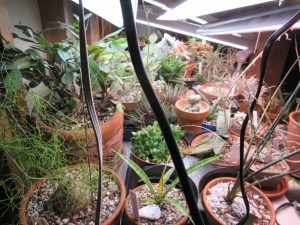 Electronic Sunshine
Electronic Sunshine
While tucking all the plants into the nooks and crannies available for winter, it’s a good time to take stock of plant health and growth through the summer. Many plants made big strides this year with our hot sunny weather. It was merely a matter of keeping up with watering. That’s something we don’t say often in the rainy Pacific Northwest! A bit of mealybug was noted in a few plants, which have now been moved to “Urgent Care” on the kitchen counter. Here they get constant vigilant attention and needed spritzing with rubbing alcohol.
 “Urgent Care”
“Urgent Care”
Our club is also wrapping up a very successful year of programs and field trips. We are enjoying an influx of new members brought about by our recent club sale. Already they have contributed ideas for programming and offered assistance with some of the ongoing club needs. This time of year our club elects new officers to carry us through the coming year and hopefully years. It takes a few months to get one’s stride as a newly elected club official, so expanding service to the club for a couple of years allows for more depth to develop in leadership. Generally the focus for the change in leadership in our club, is on the office of president. This all important person at the helm who provides support to volunteers working on special projects, who maintains the constancy of our club, who makes connections to other cactus and succulent communities, and who sets our vision is usually hard to find. Finding those willing to serve in the role of president is a challenge and even more so finding one who is visionary and possessing needed leadership skills.
While the president is carrying the vision and structure of the club there are many worker bee roles needing responsible volunteers – refreshments, name tags, room set up and tear down, A/V, field trip coordinators, mini presenters for Cactus and Succulent of the month. These are the people who pitch in on a regular basis to make sure the meeting room is comfortable and the small parts happen to make the whole. Still a bit difficult to secure these people in ongoing roles but we are seeing more step up to take on the smaller jobs.
Our club is strong, energetic and fun. It would not be this way without our able and willing volunteers. We hope for some new volunteer energy in 2019 to carry us forward. But for now, we are in good shape and looking forward to our next two meetings.
It takes a village to raise a child. It also takes a village to put on a tremendously successful plant sale. Our club is small compared to some of the clubs located in more succulent friendly climates. What we lack in numbers we make up for in passion and energy.
With a turnout of eight excited members, we transformed the donated commercial space into our own cactus and succulent store. A big shout out here to Sky Nursery in Shoreline, WA for continuing to support our sale as they have for somewhere over 28 years. We filled our ten large horticultural tables with a selection of large and small succulents in a variety of forms: dish gardens, bonsai, Halloween jack o’ lanterns, outdoor succulent gardens, cute pots, etc. There was really something for everyone, Except Lithops lovers. Those were lacking. There will be a Lithops growing push in our club’s future.
Saturday morning we were greeted by a line of shoppers outside the store, waiting to head for our sale space in a frightening imitation of salmon spawning upstream. (A sight familiar to us in the Northwest.) Crowds continued until 3:30 p.m., allowing our checkout team to get a break for the first time. We were “dazed and amazed” with the succulent fever that consumed the shoppers. One of the best things about the sale each year is that we see our fellow cactophiles who live in the area (some people drove three hours to come to the sale).

Once their shopping cart or box is full, there is time to catch up and hear about their collection. Some things heard this year: Go LED, use Milk of Magnesia to remove spines, Kalanchloe ‘Mother of Millions’ toxify the soil and nothing will grow near them, growing things in extremely small pots helps prevent overwatering, and other such tidbits. We also learned that no matter how much promo you do, people primarily use our website and Facebook to find out about the sale.
By the time the dust settled at the end of sale day on Saturday we surveyed tables nearly empty with few boxes left. Sellers scurried home to prepare more plants for sale on Sunday, and one member went dumpster diving at two local businesses for boxes. Shout outs here to Trader Joe’s and Mudbay, (a local natural petfood store) for helping out a desperate woman babbling about succulents and boxes.
We had another banner day on Sunday, the Seahawks opening season game not dampening any shopping enthusiasm. We left Sky Nursery’s space as we found it, empty, and went home with a full cash register and three well used Square Up card readers. One quit working and we thought it might possibly have melted from continual use.
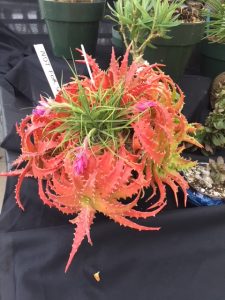
As for the initially mentioned village, we had a team of 5 checkout folks who operated as a finally tuned machine, 14 vendors who spent long hours growing and preparing plants for sale then talking to over two hundred shoppers, a staunch greeter and plant show guard who interrupted several attempts to remove show plants for purchase, rovers who assisted shoppers with boxes, questions and shared information about our club. The coordinators spent hours planning just so that when things went awry, it really didn’t matter. The sale happened, customers got exciting new plants and our club has program funds for the coming year. We feel happy.